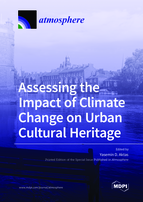Assessing the Impact of Climate Change on Urban Cultural Heritage
A special issue of Atmosphere (ISSN 2073-4433). This special issue belongs to the section "Climatology".
Deadline for manuscript submissions: closed (31 May 2020) | Viewed by 52297
Special Issue Editor
Special Issue Information
Dear Colleagues,
It is now an indisputable fact that the climate of our planet is changing, putting ever increasing pressure on the built environment and communites. In this context, cities are increasingly at the heart of the mitigation and adaptation discourse, due to growing urban populations and energy demand, further exacerbating the existing forms of urban vulnerability. Cultural heritage, which is one of the unique touch-points of our urban experience, is seen as the most critical in the face of a changing climate both for often being compromised by age, and for being irreplaceable.
It is for these reasons that Atmosphere is hosting a Special Issue dedicated to this urgent topic: urban cultural heritage under the impact of current and future climate. This impact includes both gradual climatic effects and extreme events, specifically sea level rise, floods, wind storms and cyclones, heat extremes and droughts. Complex, cascading interactions between these events, as well as how these coalesce with other stresses that are influential on urban cultural heritage are also of interest to this Special Issue. The contributions can include reviews, original research papers and case study reports using lab-based methods, in-situ monitoring or modelling to identify and quantify climatic impact, and how urban cultural heritage responds to it, which, in this context, includes both single and groups of heritage buildings, historic urban cores, museum collections, and intangible aspects of urban heritage. Contributions focussing on climate risk management and policy development, and novel methods of retrofit aimed at enhancing the climate resilience of urban cultural heritage are also welcome.
Dr. Yasemin D. Aktas
Guest Editor
Manuscript Submission Information
Manuscripts should be submitted online at www.mdpi.com by registering and logging in to this website. Once you are registered, click here to go to the submission form. Manuscripts can be submitted until the deadline. All submissions that pass pre-check are peer-reviewed. Accepted papers will be published continuously in the journal (as soon as accepted) and will be listed together on the special issue website. Research articles, review articles as well as short communications are invited. For planned papers, a title and short abstract (about 100 words) can be sent to the Editorial Office for announcement on this website.
Submitted manuscripts should not have been published previously, nor be under consideration for publication elsewhere (except conference proceedings papers). All manuscripts are thoroughly refereed through a single-blind peer-review process. A guide for authors and other relevant information for submission of manuscripts is available on the Instructions for Authors page. Atmosphere is an international peer-reviewed open access monthly journal published by MDPI.
Please visit the Instructions for Authors page before submitting a manuscript. The Article Processing Charge (APC) for publication in this open access journal is 2400 CHF (Swiss Francs). Submitted papers should be well formatted and use good English. Authors may use MDPI's English editing service prior to publication or during author revisions.
Keywords
- urban cultural heritage
- climate-induced urban hazards
- climate resilience
- extreme weather events
- climate vulnerability assessment
- climate adaptation and mitigation
- climate risk management for cultural heritage






